How an Engine Works - 3.5L V6 Teardown!
#1
Lexus Champion
Thread Starter
I took apart the engine on my Infiniti G35 and would like to share with you all the tear-down and how it works:
This is Nissan / Infinitiís popular 3.5L VQ35DE V6 engine, used in many vehicles since the early 2000ís.
Hereís the engine, on the stand and the major components that surround it:
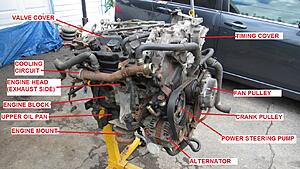
On top of the engine are the ignition coils. There are 6 total in this V6 engine, three on each bank:
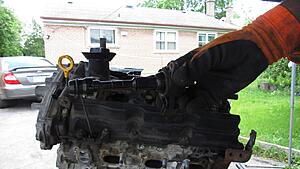
With all the accessories, hoses, brackets, belts and mounts removed, hereís what the front of the engine looks like after removing the access covers on the timing cover:
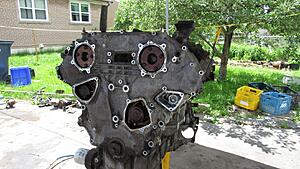
The oil pan was removed next, where we have a look at the oil pump and pickup tube. Thereís two bolts under here that secure the front timing cover:

Hereís the timing cover removed, with all the associated timing components. The timing system is responsible for correctly positioning the intake and exhaust valves within each cylinder during their respective position in the combustion cycle. The system is driven by the crankshaft, up through a timing chain, then across two intake camshafts. Auxiliary chains drive the exhaust camshafts.
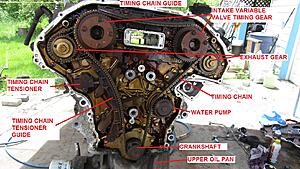
With the valve cover removed, we have a look at the intake and exhaust camshaft. Each has a lobe on it that push down on the tappet to open the valve.
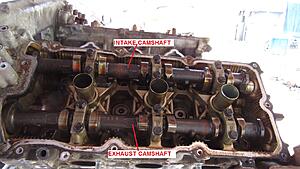
The rear timing cover is removed next:
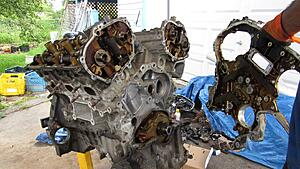
The camshaft cap (which also houses the VVT-I solenoid and auxiliary timing tensioner) is removed next:
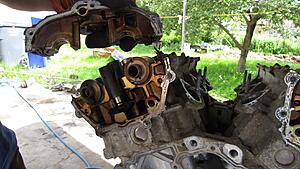
Thereís 8 head bolts per head to remove and then the engine head (that holds the valves, spark plugs and camshafts) can be removed from the engine block revealing the pistons:
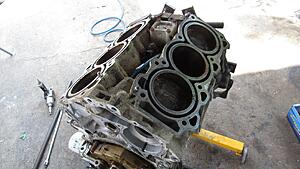
Underneath the block, with the upper oil pan removed, we have the crankshaft, held on by its main bearings through a bearing holder:
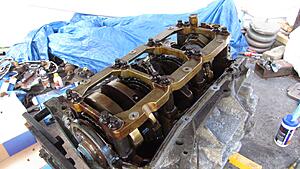
I busted my socket removing these external torx e14 main bearing bolts with an impact!
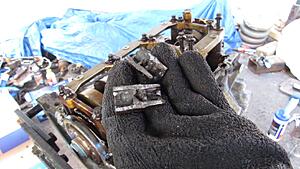
Hereís what the crankshaft looks like inside the engine block. Itís the heavy hauler in an engine, and is driven by the pistons that move in a crank-slider like mechanism. Once piece of heavy steel! Notice how the pistons are offset for each bank for this V6 engine.
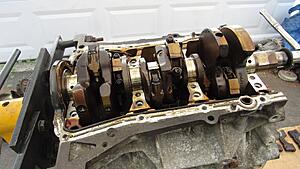
Hereís the piston removed and its components:
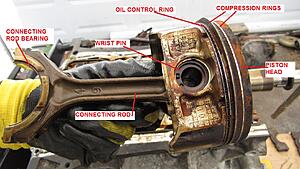
This is the rear main seal that separates the oily part of the engine from the transmission outside:
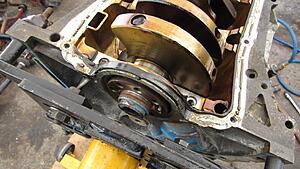
Crankshaft removed:
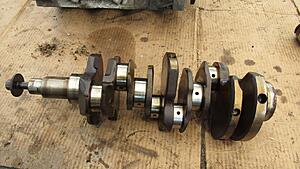
The cylinders are lined with steel since the block is aluminum. You can also see the oil jet sprayer that coat the cylinder walls for lubrication.
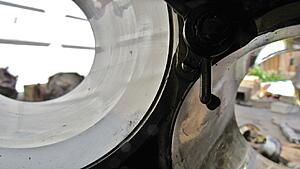
Hereís a look under the engine head at those valves. The intake valves had quite a bit of carbon buildup.
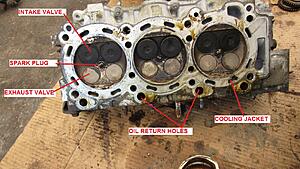
And this is the valve removed, with its return spring:
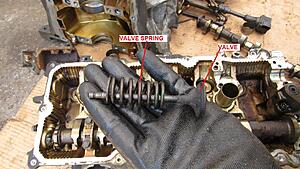
And thatís pretty much all the components that go into an engine!
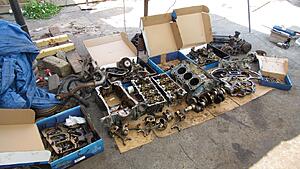
Enjoy
This is Nissan / Infinitiís popular 3.5L VQ35DE V6 engine, used in many vehicles since the early 2000ís.
Hereís the engine, on the stand and the major components that surround it:

On top of the engine are the ignition coils. There are 6 total in this V6 engine, three on each bank:

With all the accessories, hoses, brackets, belts and mounts removed, hereís what the front of the engine looks like after removing the access covers on the timing cover:

The oil pan was removed next, where we have a look at the oil pump and pickup tube. Thereís two bolts under here that secure the front timing cover:

Hereís the timing cover removed, with all the associated timing components. The timing system is responsible for correctly positioning the intake and exhaust valves within each cylinder during their respective position in the combustion cycle. The system is driven by the crankshaft, up through a timing chain, then across two intake camshafts. Auxiliary chains drive the exhaust camshafts.

With the valve cover removed, we have a look at the intake and exhaust camshaft. Each has a lobe on it that push down on the tappet to open the valve.

The rear timing cover is removed next:

The camshaft cap (which also houses the VVT-I solenoid and auxiliary timing tensioner) is removed next:

Thereís 8 head bolts per head to remove and then the engine head (that holds the valves, spark plugs and camshafts) can be removed from the engine block revealing the pistons:

Underneath the block, with the upper oil pan removed, we have the crankshaft, held on by its main bearings through a bearing holder:

I busted my socket removing these external torx e14 main bearing bolts with an impact!

Hereís what the crankshaft looks like inside the engine block. Itís the heavy hauler in an engine, and is driven by the pistons that move in a crank-slider like mechanism. Once piece of heavy steel! Notice how the pistons are offset for each bank for this V6 engine.

Hereís the piston removed and its components:

This is the rear main seal that separates the oily part of the engine from the transmission outside:

Crankshaft removed:

The cylinders are lined with steel since the block is aluminum. You can also see the oil jet sprayer that coat the cylinder walls for lubrication.

Hereís a look under the engine head at those valves. The intake valves had quite a bit of carbon buildup.

And this is the valve removed, with its return spring:

And thatís pretty much all the components that go into an engine!

Enjoy
#3
Lexus Fanatic
Thanks for sharing, speedkar......excellent post as usual. That engine had a great reputation.....at one time, considered one of the World's 10 Best engines by several different automotive organizations. As you illustrated, it has a nice steel timing chain instead of those crap-rubber timing-belts that wear out, break, and/or have to be replaced every 5 years or so, driving up maintenence costs, especially with transverse-mounted engines where they can be difficult to reach.
The carbon build-up on the valves that you illustrate can be caused by several different sources (among them Direct-Injection), but a very common reason is people using cheap, cut-rate-brand gas, which is OK as far as octane is concerned, but often doesn't have the necessary amount of detergent additives to keep deposits from building up (It's cheaper for a reason). That is a subject I have cautioned about a number of times, in previous posts. In general, the Tier-One brands of fuel will have enough detergent in them to keep deposits from building up. I've generally had the best luck with Chevron's Techron/Techrolene and Shell's V-Power additives, but, for reasons I don't know, Chevron fuel is no longer available in the immediate area where I live...they closed their Northern Virginia stations and/or converted some of them to the Liberty brand.
The carbon build-up on the valves that you illustrate can be caused by several different sources (among them Direct-Injection), but a very common reason is people using cheap, cut-rate-brand gas, which is OK as far as octane is concerned, but often doesn't have the necessary amount of detergent additives to keep deposits from building up (It's cheaper for a reason). That is a subject I have cautioned about a number of times, in previous posts. In general, the Tier-One brands of fuel will have enough detergent in them to keep deposits from building up. I've generally had the best luck with Chevron's Techron/Techrolene and Shell's V-Power additives, but, for reasons I don't know, Chevron fuel is no longer available in the immediate area where I live...they closed their Northern Virginia stations and/or converted some of them to the Liberty brand.
#4
Lexus Champion
Thanks for the great write-up!
I have one question: I assume you meant "VVT" rather than "VVT-I"?
"VVT" is the accepted abbreviation for Variable Valve Timing (without regard for any automaker's specific technology).
"VVT-i" (Variable Valve Timing with Intelligence) is the name given to Toyota's specific variable valve timing technology. Nissan does not use Toyota technology.
Sorry for nit-picking.
I have one question: I assume you meant "VVT" rather than "VVT-I"?
"VVT" is the accepted abbreviation for Variable Valve Timing (without regard for any automaker's specific technology).
"VVT-i" (Variable Valve Timing with Intelligence) is the name given to Toyota's specific variable valve timing technology. Nissan does not use Toyota technology.
Sorry for nit-picking.
#5
Lexus Champion
I watched that whole thing--I assume that engine was toast?
I had a 2002 Infiniti I35 with the 255hp version of that 3.5, it was a smooth beast. The thing was geared terrible though so it wasn't as quick as it should have been.
I had a 2002 Infiniti I35 with the 255hp version of that 3.5, it was a smooth beast. The thing was geared terrible though so it wasn't as quick as it should have been.
#6
Lexus Fanatic
That was probably one of the reasons why Nissan switched to CVTs for a lot of its products.....though I never had much faith in the reliability of those early CVTs (particularly with larger engines) and history, more or less, bore that out.
#7
Lexus Champion
Yep, and that's why I have no desire for any Nissan product anymore. I can't stand CVTs; I don't like the way they drive. It's a deal breaker for me.
Trending Topics
#8
#9
Lexus Fanatic
@mmarshall as far as I know, the VQ motors of that era used port injection not direct injection.
#10
Lexus Champion
I also had a 97 Maxima with the original 3.0 VQ that everyone gushed about....that motor was a gem. Felt way stronger than 190hp. It was a manual, too. Other than my LS430 it was by far my favorite car I've had.
#11
Lexus Champion
Thread Starter
Thanks for the great write-up!
I have one question: I assume you meant "VVT" rather than "VVT-I"?
"VVT" is the accepted abbreviation for Variable Valve Timing (without regard for any automaker's specific technology).
"VVT-i" (Variable Valve Timing with Intelligence) is the name given to Toyota's specific variable valve timing technology. Nissan does not use Toyota technology.
Sorry for nit-picking.
I have one question: I assume you meant "VVT" rather than "VVT-I"?
"VVT" is the accepted abbreviation for Variable Valve Timing (without regard for any automaker's specific technology).
"VVT-i" (Variable Valve Timing with Intelligence) is the name given to Toyota's specific variable valve timing technology. Nissan does not use Toyota technology.
Sorry for nit-picking.
Thanks for sharing, speedkar......excellent post as usual. That engine had a great reputation.....at one time, considered one of the World's 10 Best engines by several different automotive organizations. As you illustrated, it has a nice steel timing chain instead of those crap-rubber timing-belts that wear out, break, and/or have to be replaced every 5 years or so, driving up maintenence costs, especially with transverse-mounted engines where they can be difficult to reach.
Lets just say the rest of the car wasn't in road worthy shape to be worth fixing. The engine did run fine, but I have other plans for it

One day I hope to get a CVT to take apart and do a teardown on....
Thread
Thread Starter
Forum
Replies
Last Post







